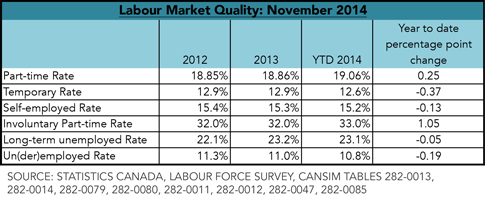Our content is fiercely open source and we never paywall our website. The support of our community makes this possible.
Make a donation of $60 or more and receive The Monitor magazine for one full year and a donation receipt for the full amount of your gift.
After a gain of 37,000 jobs in October, Ontario posted a loss of 33,900 jobs in November.
Unfortunately, 80% of those losses were in full-time work.
Ontario’s year-to-date unemployment rate is now 7.3%. The province’s employment rate, which provides a snapshot of how many people are actually working in paid employment, nudged down a bit: year-to-date, Ontario’s employment rate is 61.2%. To put that into perspective, the employment rate in 2012, post-recession, was 61.3% and in 2013 it was 61.4%.
The November job numbers run counter to an overall trend in 2014: the year featured nine months of net job growth and two months of net job losses.
Involuntary part-time work in Ontario continued to climb in November: one third of all people who are working part-time in Ontario would rather be working full-time.
Going concern: Windsor remains home to the highest unemployment rate in the province at 7.9%, followed closely by Toronto at 7.5%.
A green shoot of hope: Youth unemployment was lower in 2014 than in the previous two years – though at 15.7%, youth unemployment in Ontario remains twice as high as the overall unemployment rate.


Kaylie Tiessen is an economist with the Ontario office of the Canadian Centre for Policy Alternatives (CCPA-Ontario). Follow her on Twitter @KaylieTiessen.


